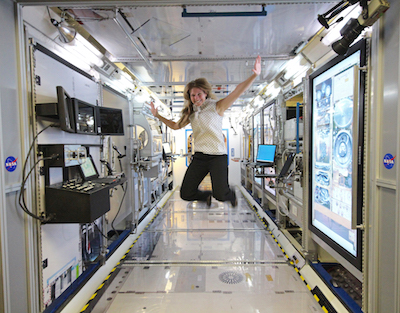
| |
| calendar |
| speakers |
| resources |
| blog |
| contact |
| Sarah D. Mitchell, MSE, MBA |
Marin Science Seminar Presentation: "Biology in Space: Understanding How Luke Skywalker, Mark Watney, and Captain Jean Luc-Picard Survive" (March 16, 2016) Get the March 2016 flyer here. Understanding how life exists and functions in the space environment has been a necessity since the beginning of space travel. A source of intrigue, curiosity, and practicality, biology in space remains a frontier to be conquered by scientists, medical doctors, and science fiction writers alike. The Space Biosciences Division at NASA Ames Research Center has long been a leader in this field and continues to strive for bringing life into space and applying what is learned to life on Earth. Destined for the International Space Station (ISS), the Bioculture System payload contains ten cassettes for incubating cells on-orbit and will allow for initiation, maintenance, and return of live cell cultures – a feat never obtained before. The Bioculture System is only one of many exciting projects that the Space Biosciences Division is currently developing to further our understanding of biology in space. Lofty goals such as human space flight travel to asteroids, the moon, or Mars make this research essential. What more do we need to learn about biology in space before travel to Mars is truly safe and possible for humans? Sarah D. Mitchell works for Logyx, LLC supporting International Space Station (ISS) flight research projects in the Space Biosciences Division at NASA Ames Research Center (ARC) in Mountain View, CA. She currently manages the Project Operations team for the Cell Science payload, a cell incubator system that will fly to the ISS aboard the SpaceX Dragon Capsule. She also supports Task and Line Management contract efforts. After graduating from University of Michigan with a BSE in Aerospace Engineering in 2003, Sarah's professional engineering career began with solar science telescope projects at Lockheed Martin's Solar and Astrophysics Laboratory (LMSAL) at the Advanced Technology Center (ATC) in Palo Alto, CA. Here she performed Systems Engineering, Integration and Test, Operations, and Project Management tasks for several different NASA missions. One major highlight of this work was her accomplishments developing and operating the Solar Dynamic Observatory (SDO) Atmospheric Imaging Assembly (AIA) instrument, where she was given the distinct honor of pressing the button that opened the instrument's "eyes" for the first light images of the sun. Along with her project work, Sarah has participated in research studying the impacts of solar weather on human infrastructure and space technology collaboration opportunities. Sarah earned her MBA and Masters in Engineering Management from San Jose State University in 2008. While immensely enjoying her work, Sarah also enjoys yoga, hiking, traveling, and photography. |
